Moving Beyond the Traditional 7 Layers of a Food Forest
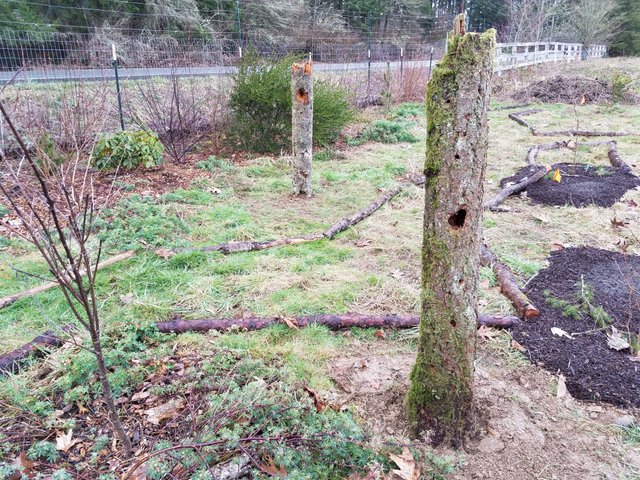
Are there more than 7 layers in a food forest? I think so and I'm going to share with you all why. But I also want your feedback. Is this a crazy idea? Or does it make sense? Is it interesting? I may write a full blog post all about this concept but I want to see what you all think first.
Before I outline the new layers I think should be added to the food forest model here is a brief overview of what a food forest is and the traditional 7 layers. National Geographic has a great quick video all about food forests that I highly recommend as a good intro to the topic.
In brief a food forest is a system that mimics the natural structure of a forest to grow an abundance of food, wood, medicine, etc. for human consumption. A food forest (aka forest garden) is the ultimate expression of working with nature to generate a useful harvest for your homestead.
The traditional layers are:
- A canopy layer with large fruit or nut trees (support trees and timber trees could be here too)
- A sub-canopy layer of smaller trees such as dwarf fruit trees (coppiced trees could be here)
- A shrub layer for fruiting bushes but again support plants such as nitrogen fixing shrubs work too
- The herbaceous layer for herbs (cooking and medicinal), flowers, vegetables, etc.
- Ground cover as a living mulch which can be edible.
- The root crops
- And a layer consisting of vines and climbers
Each of these layers would blend together in a natural forest and a forest garden tries to mimic that. Though sometimes you may choose to keep it as an open woodland with greater spacing between the large trees so more sun reaches the ground for the lower layers.
Instead of calling these the traditional layers how about we call them the living layers--sound good?
My Proposed Addition to this Model
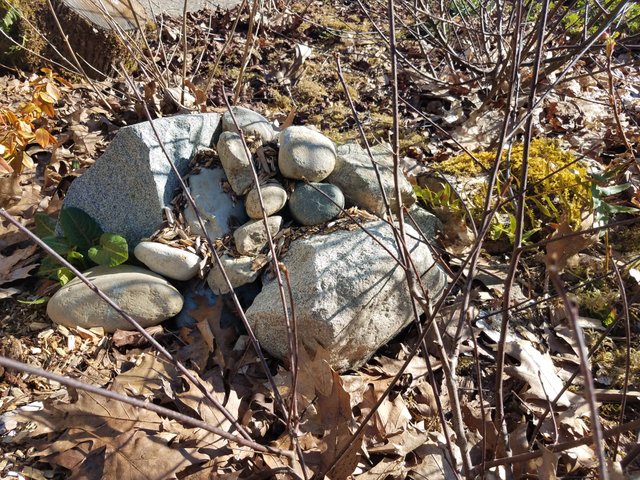
This is all building off of what I was talking about in this week's blog post about rewilding your homestead. In that post I talk about adding features such as snags (dead standing trees) to your homestead. I do this on mine by taking old logs and "planting" them upright.
For my day job I run large restoration projects across 4 counties in the South Puget Sound in WA. I have also done habitat assessments in Idaho and Washington for past jobs. Plus I grew up running through forests around the small rural Eastern WA town I grew up in. All of this has taught me that a forest is not just made up of the living elements such as plants and wildlife. The non-living elements such as rocks, woody debris, snags, etc. are a core part of a healthy vibrant forest.
So what does that mean for a food forest? Well these non-living elements tend to be ignored overall. To help change that I propose these layers be added to the food forest model:
- Large snags (10+ feet high and 1+ feet across)
- Small snags (Less than 10 feet high)
- The stump layer (Short and thick woody debris that mimic a stump)
- Large woody debris (logs, root wads, etc. laying on the ground)
- Rocks (both rock piles and individual large rocks)
- Small woody debris (twigs, branches, etc.)
- Mulch layer (leaves, wood chips, etc.)
The large snags might not always be safe in a food forest that sees a lot of traffic and they would be difficult to install. But if you have a large tree die then this could be an opportunity to cut it down to a safe but still tall height and remove the limbs. If large enough these snags are great habitat for woodpeckers, owls, and other birds plus other wildlife.
Small snags are easier and can be installed just like a fence post. I have added several of these to my homestead.
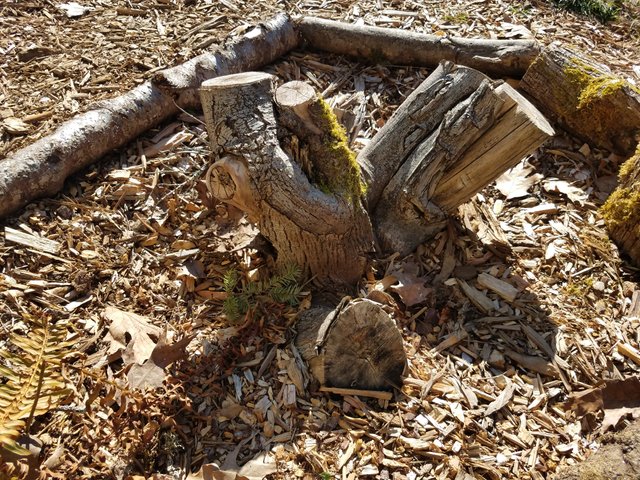
This is an example of a relatively small "stump" added to my in-progress food forest. The picture at the start of this section shows a small rock pile and here is an example of a larger one at one of my restoration sites.
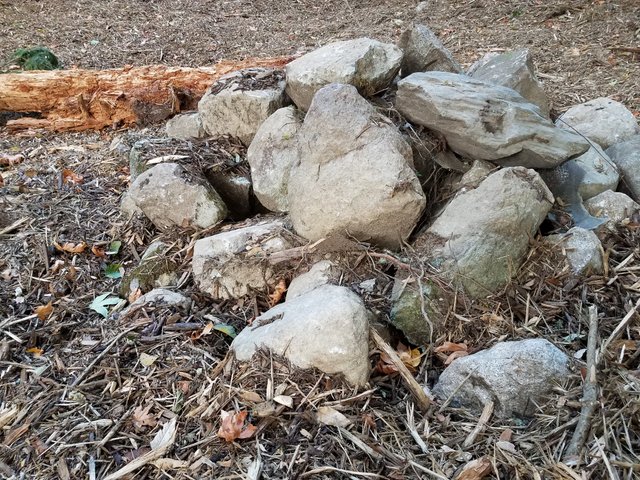
Amphibians and reptiles love to hide in these rock piles. They can also capture a small amount of water and create a moist area below them that plant roots can tap into.
If you look at a forest floor there is a layer made up of logs, branches, leaves, etc. This layer to me is what truly defines something as a forest. The result is a fungal dominated system that is great for trees and shrubs. It is filled with life and also works as a sponge soaking up water and keeping the forest hydrated through dry spells. It also creates rich soil as it breaks down.
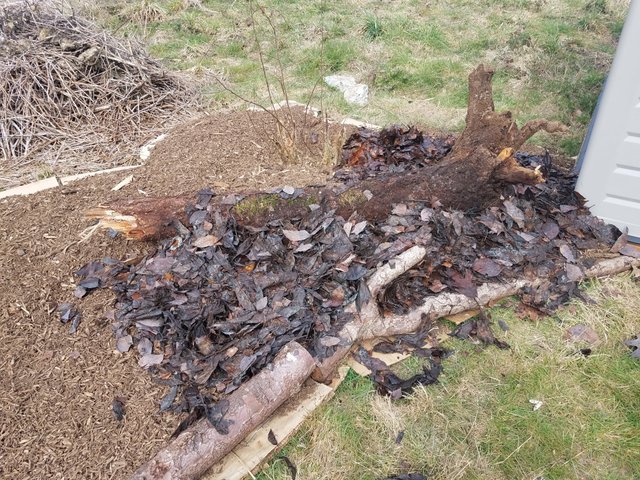
Here you can see one of my new planting areas in my in-progress food forest. I added a large log plus wood chips and fall leaves. All of this is to mimic a natural forest floor. I could add some branches and of course I need to add a lot more plants.
Each element in these layers would only provide a small benefit. But just like the original living layers of a food forest it is the interaction of them all together that adds complexity and diversity to the system. This is what can truly create a vibrant and abundant system.
Putting it all together
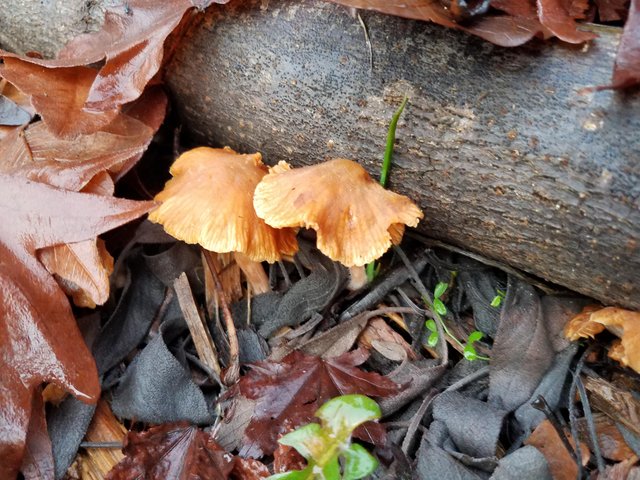
In this expanded model of a food forest there would be 7 living layers and 7 non-living layers. My view is that a forest is only truly a forest if it has at least a portion of these 7 non-living layers. From fungal systems to woodpeckers so much of the life of a forest depends on these non-living elements.
So what do you all think?
Please share your thoughts below I would love to hear from you all!
I really like this idea and have always loved the idea of growing food in a “food forest” way or, you know, how stuff grows naturally 🙃
I’ll be honest though, I didn’t realize there were a specific “7 layers” and feel your additions just make sense. We as humans can make a beautiful food forest but leaving out the non living things you have mentioned here means we still are interfering in a way.
Clearly some things won’t work for some that will work for others, but I think habitats that welcome beneficial animals and decaying logs/stumps that just add beneficial nutrients to the soil are well, beneficial.
Thanks for this right up, your blog is very well done!
Thank you! :) Yeah, the layers were in some of the first books discussing the idea and have been used since. I have seen some people expand them to include wetlands and aquatic plants but so far I had not seen anyone expand them to include the non-living forest elements.
Appreciate the comment! :)
This post is sponsored and featured by @Appreciator in collaboration with @c-squared. Just keep up the good work.
I couldn't agree with you more. It is nice that the science is slowly coming around to acknowledging the importance of these non-living elements, more and more I see snags and stumps being left in place in conservation areas where they might have been removed in the past. It just makes intuitive sense - we need to provide as close to the natural habitat as possible to have as healthy and sustainable of a mini-ecosystem in our gardens as possible. This is the way to totally eliminate reliance on fertilizers, pesticides, etc., needed when the balance is out of whack. GREAT article!
Thank you! :) I'm happy to see the since changing too though in ecology it has been fairly well understood for a while. Just hard to get that understanding out to land owners, land managers, and people implementing the science.
Really appreciate the comment! Thank you!
Man this is so excellent... I enjoy your shared thoughts. Your way gives me lots of ideas to implement in "my" garden. Thank you for this! BTW your points of adding another 7 layers makes sense to me.
Thank you! :) I hope you will share some pictures when you get your garden implemented. I would love to see what you end up doing. Thanks for the comment!
This post was shared in the Curation Collective Discord community for curators, and upvoted and resteemed by the @c-squared community account after manual review.
@c-squared runs a community witness. Please consider using one of your witness votes on us here
Yes!!! Here in Australia you can't collect fallen logs from a forest UNLESS it's a designated wood collecting area. This is BECAUSE of the insects and wildlife that live there that add to the ecosystem. In my garden (though not QUITE a food forest in that sense although some parts are getting that way) I make sure I have socks and hollow logs for insects and blue tongue lizards. Scary.for snakes but worth the risk.. none so far Thank god..
Posted using Partiko Android
Yeah, I'm lucky here that the snakes are all "friendly". They just like to eat slugs ;) But even if I had snakes I needed to be careful with I would still use these features but I would put them away from the main harvesting and walking areas.
As far as collecting wood I go to forests that are going to be torn down and built on. These development sites are a great way to get good material without hurting a site.
Thanks for the comment and I like the picture!
You're welcome! I thought it was important to show you what kind of creatures might live in our garden in Australia! They aren't poisonous, but have very strong jaws and often scare the bejesus out of me when they rustle about! Found two baby ones the other day - soooo cute!
Whoops, I guess you've been visited by @nateonsteemit out of silliness and failure to pay attention to what account he's logged in with! I'm a serial Messer upper like that, but I don't think it matters this time because this post is awesome and definitely features a regenerative model!
I love it! Naturally, as your forest matures, these things would happen anyways. But this adds the biosecurity of that maturity earlier on. Quite insightful! I've often wondered about this stuff. I've got a big oak that'll probably have to come down eventually and I have considered helping the trunk in the ground and innoculating it with mycelium to add another food and medicine crop, so I'm right there with you. And over (lots of) time, those rocks break down into minerals too!
lol, thank you! :) I agree but in food forests I see a lot of people managing their forests in a way that prevents these features from naturally being part of the forest.
People often cut down dead trees instead of leaving them as snags. Branches are often hauled away, etc.
In addition to adding these elements at the start of a food forest I also hope by talking about it more people will change how they manage their forests to let it be a bit more wild :)
Getting that oak part way into the ground sounds like a great idea to me!
I appreciate the comment! :)